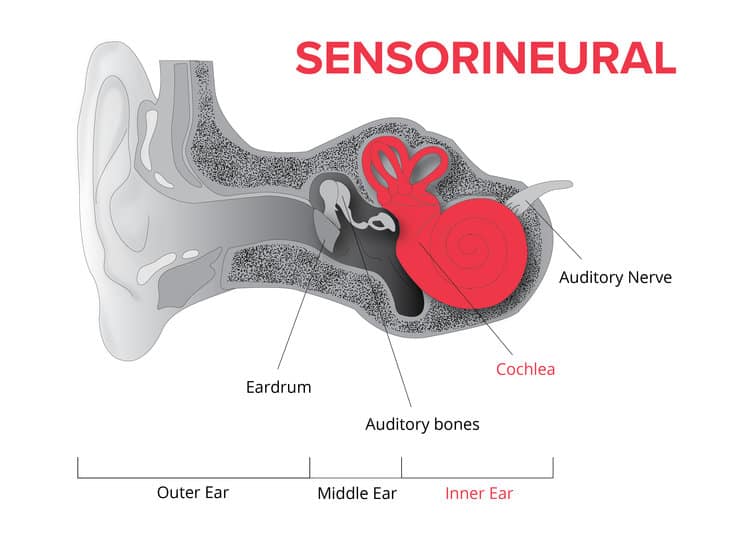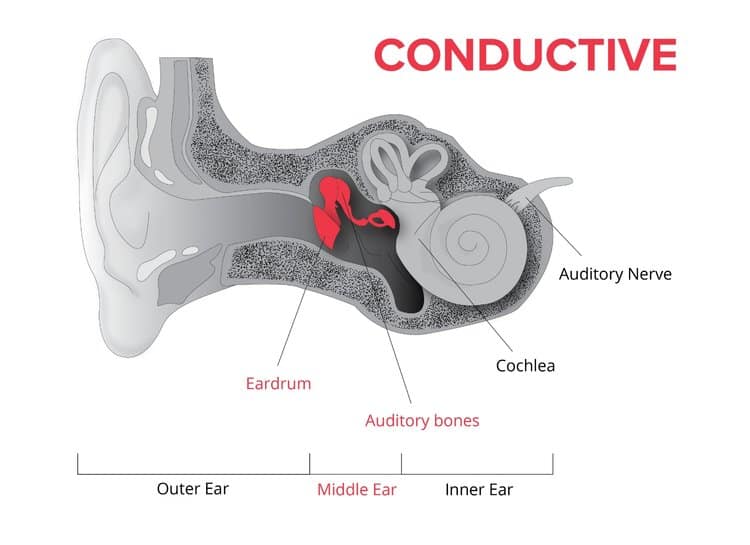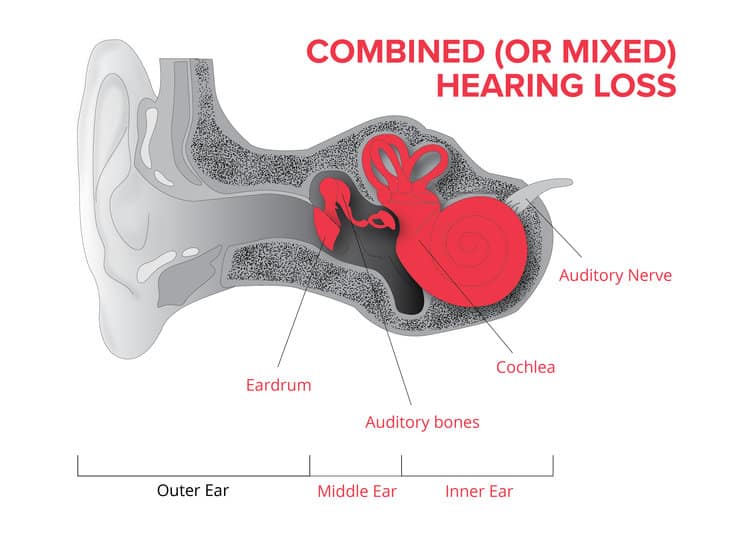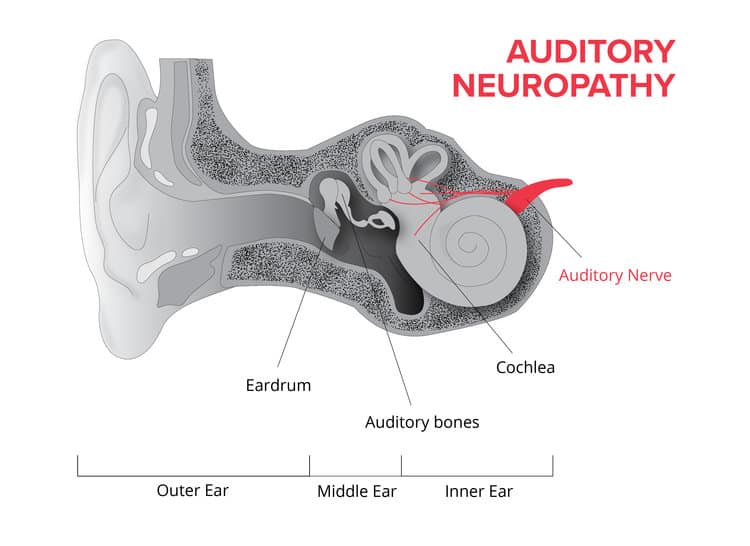Speech & Hearing Associates of NJ provides an explanation of each of the three basic types of hearing loss: 1) sensorineural, 2) conductive, and 3) mixed and the degrees of hearing loss. If you have any questions about hearing loss or how we can help you with hearing loss please contact us today!
Types of hearing loss
Sensorineural Hearing Loss:

The vast majority of people with hearing loss have sensorineural hearing loss (pronounced sen(t)sərēˈn(y)o͝orəl). This occurs when there is a problem with the sensory (hair cells) and/or neural structures (nerves) in the inner ear (cochlea). Most often, sensorineural hearing loss involves damage to the tiny hair cells that are activated by sound waves to vibrate and release chemical messengers that stimulate the auditory nerve. The auditory nerve is made up of many nerve fibers that then carry signals to the brain that are interpreted as sound. While sensorineural hearing loss usually involves damage to the tiny hair cells, it also can result from damage to the auditory nerve.
A sensorineural hearing loss reduces the intensity of sound. But a sensorineural hearing loss also can distort what is heard—even when the sounds are loud enough. That is why people with sensorineural hearing loss often struggle to hear words clearly—particularly certain spoken consonant sounds and when in noisy environments.
Most sensorineural hearing loss cannot be reversed with medical treatment and is typically described as an irreversible, permanent condition. Nevertheless, research into a cure continues.
The good news is that once any underlying medical conditions have been ruled out or addressed, most people with sensorineural hearing loss can benefit from hearing aids.
Ninety-one percent of people who purchased hearing aids in the last year say they’re satisfied, in fact. And 90 percent say they’d recommend getting hearing aids to family members and friends.
Some of the potential causes of sensorineural hearing loss include:
• Exposure to loud noise
• Aging
• Medicines that damage the ear (ototoxic)
• Illnesses, such as meningitis, measles and certain autoimmune disorders, among others
• Genetics—that is, hearing loss runs in the family
• Trauma to the head
• Structural malformation of the inner ear
Conductive Hearing Loss:

Conductive hearing loss is mechanical in nature. That means that something—a physical condition or disease—is stopping sound from being conducted from the outer or middle ear to the inner ear, where nerves are stimulated to carry sound to the brain.
Often, the cause of conductive hearing loss can be identified and treated. Medical treatment of conductive hearing loss often allows for partial or complete improvement in hearing. Then, hearing aids are usually helpful in compensating for any remaining hearing loss.

Potential causes of conductive hearing loss include:
• Wax buildup
• Fluid in the middle ear due to colds or allergies
• Fluid in the middle ear due to poor eustachian tube function (The eustachian tube drains fluid from the middle ear and ventilates it to regulate air pressure there.)
• Ear infection
• A foreign object lodged in the ear
• A ruptured eardrum (also called a perforated eardrum or a tympanic membrane perforation), which means there is a tear in the membrane that separates the outer ear from the middle ear
• Structural malformation of parts of the ear
• Trauma to the ear
• In rare cases, tumors
Mixed Hearing Loss:
A mixed hearing loss means there is a sensorineural hearing loss along with a conductive hearing loss component. In addition to some irreversible hearing loss caused by a problem with the inner ear, there also is an issue with the outer or middle ear, which makes the hearing loss worse. But it may be possible to successfully treat the conductive hearing loss, as explained above. Following treatment, the individual also may benefit from hearing aids to help manage the remaining sensorineural hearing loss.
Auditory Neuropathy

In this rare type of hearing loss, sound enters the inner ear normally but the transmission of signals from the inner ear to the brain in impaired. Those with auditory neuropathy, regardless of an underlying hearing loss, have trouble with speech-perception or understand speech clearly.
What about presbycusis, noise-induced hearing loss, tinnitus, and central auditory processing disorders?
Presbycusis:
Presbycusis (pronounced prez-bi-ˈkyü-səs) simply means age-related hearing loss. Typically, presbycusis comes on gradually and equally in both ears. In most cases, it’s the result of changes in the ear that happen as people get older.
Often, presbycusis involves damage to the inner ear, making it a sensorineural hearing loss. Cardiovascular disease, diabetes, other health conditions common with aging, and ototoxic medications that can damage the inner ear all can contribute to presbycusis. In addition to what aging does to the inner ear, common age-related changes to the brain can make it more difficult to understand conversations in challenging listening situations such as in restaurants or when several people are talking at once.
Noise-induced Hearing Loss:
Noise-induced hearing loss is a type of sensorineural hearing loss. It’s caused by damage to the delicate hair cells in the inner ear that vibrate in response to sound waves. Just as we can overload an electrical circuit, we can overload these hair cells with too much noise or sounds that are too loud. The hair cells that enable us to clearly hear higher-frequency sounds tend to go first.
Although noise-induced hearing loss is largely preventable, it’s a significant societal problem due to so much noise in the world around us.
Any sounds at or above 85 decibels for a prolonged period of time can be unsafe to a person’s hearing. (The intensity of sound is measured in decibels.) To put that in perspective, most heavy city traffic and school cafeterias are at about 85 decibels, and fireworks are in the 140-to-165 decibels range, according to It’s A Noisy Planet. It’s also important to realize that something like the single bang of a firecracker at close range can permanently damage hearing in an instant.
Because noise-induced hearing loss is so common, attributing gradual hearing loss over time strictly to aging can be somewhat misleading. In middle-aged and older people, it’s often difficult to distinguish what percentage of a sensorineural hearing loss is attributable to aging and what percentage is the result of repeated exposure to noise.
About 40 million U.S. adults aged 20 to 69 years have noise-induced hearing loss, according to the Centers for Disease Control and Prevention (CDC). And nearly 50 percent of 12 to 35-year-olds are exposed to unsafe levels of sound from the use of personal audio devices, based on data analyzed by the World Health Organization (WHO). Around 40 percent of 12 to 35-year-olds are exposed to potentially damaging levels of sound at entertainment venues.
Tinnitus:
Often called “ringing in the ears,” tinnitus is the perception of a sound in a person’s ears or head that has no external source. Many people with tinnitus experience a ringing, humming, buzzing, or chirping sound. Others even perceive singing or music. Experts believe that neural hyperactivity—that is, overstimulation of the nerves—leads to this perception of sound.
Often, tinnitus is the by-product of noise exposure, although it can be caused by other things as well. Tinnitus is almost always accompanied by hearing loss and is considered a symptom of hearing loss.
Many people can manage the annoyance associated with tinnitus with hearing aids. A good number of high-tech hearing aids now include integrated “sound therapy” specifically designed to offer relief from tinnitus.
Unfortunately, teenagers are increasingly experiencing tinnitus, possibly as a result of frequent noise exposure.
Click here to learn how to manage your tinnitus.
Central Auditory Processing Disorders:
Auditory Processing Disorders (APD), also known as Central Auditory Processing Disorder (CAPD) is the reduced or impaired ability to discriminate, recognize or comprehend complex sounds, such as those used in words, even though the person’s hearing is normal. For example, understanding boat for coat or the not being able to discriminate the difference in sounds between “sh” and “ch” It is a complex problem that affects about 5% to 7% of school-aged children and it is twice as often diagnosed in boys than in girls.
Although it is difficult to understand, APD is not a problem with hearing per se. The problem lies in the hearing process. In children/adults with APD these electrical signals that come from the sound waves into the ear and are sent to the brain arrive with a delay or distortion, which makes learning and memorizing very difficult.
Click here for more information about auditory processing disorders.
Degrees of hearing loss
When someone is professionally diagnosed with hearing loss, typically they’re told how significant the hearing loss is. The degree of hearing loss can range from “mild” to “profound,” but the question for most people is, “What does that mean for me?”
Below is a brief explanation of the degrees of hearing loss. Generally, the more severe the hearing loss, the harder it is for the person to hear.
Mild
“Mild” is the most common and under-diagnosed degree of hearing loss.
People with mild hearing loss usually can hear sounds louder than 40 decibels, but may have some difficulty hearing sounds below 40 decibels.
Here’s how that translates into real life: Soft speech is about 50 decibels. The humming of a refrigerator is about 40 decibels; a whisper is about 30 decibels; rustling leaves are about 20 decibels; and the sound of normal breathing is about 10 decibels.
So, someone with mild hearing loss may have minimal or no issues communicating in quiet, in one-on-one settings, or with only a couple of people. But they tend to have difficulty hearing softer environmental sounds as well as some conversations, especially in noisier environments, at a distance, in larger-group settings, or over the phone.
For instance, someone with mild hearing loss may only notice that they have trouble making out the conversation in certain situations—like in a noisy restaurant or when there is background music. Or, they may have trouble with certain words—typically with consonant sounds like “s,” “f,” or “th.” They may hear the word, but they may strain to distinguish it clearly or think something else that sounds similar was said. For example, someone with mild hearing loss may think the speaker said “hurt” when it was “shirt,” or “fun” when it was “sun,” and so on.
When hearing loss is related to noise exposure and aging, people tend to lose their ability to hear higher frequency (pitch) sounds first—like consonants in speech, which are higher pitched and softer in volume than vowels. This is challenging because consonants contribute much more than vowels to our understanding of speech.
People with mild hearing loss also may need to work harder to follow the conversation when a woman or child is talking. They also may miss very high-pitched sounds, like higher-pitched birds or alarms.
The bottom line is that someone with unaddressed mild hearing loss may need to put more cognitive effort (higher levels of concentration) into following conversations in certain situations than they realize. The cumulative strain, especially for individuals with active professional, social, and civic lifestyles, can be significant and draining.
Moderate
People with moderate hearing loss have trouble hearing sounds below 40 decibels, but also many sounds in the 41 to 60 decibels range. Sounds in the 41 to 60 decibels range include those heard in a quiet office, for example. Normal conversational speech averages between 50 and 65 decibels.
By the time someone has moderate hearing loss, the person often strains to keep up with conversation in most settings without the use of hearing aids or other assistive listening devices.
Severe
People with severe hearing loss have difficulty hearing most sounds below 61 decibels and many between 61 and 80 decibels. Sounds in the 61 to 80 decibels range include a vacuum cleaner or hairdryer (about 70 decibels) and a garbage disposal (80 decibels).
In day-to-day life, that means that someone with untreated severe hearing loss would have trouble following most conversations. They likely would have difficulty even hearing loud speech without amplification, such as hearing aids.
Profound
Someone with profound hearing loss can only hear very loud sounds—those above 81 decibels. A lawnmower and food blender are between about 85 and 90 decibels. A motorcycle, at about 25 feet away, is 88 decibels.
A person with a profound hearing loss probably would not hear any speech and only very loud sounds. They most often have difficulty hearing and following the conversation even with hearing aids and often rely on lip-reading and/or sign language. Individuals with profound hearing loss may benefit from a cochlear implant, a device that is surgically implanted to substitute for the severely damaged cochlea.
We strongly encourage people struggling with hearing loss to contact Speech And Hearing Associates. Addressing hearing loss can have a tremendously positive impact on a person’s everyday life.
Call Speech & Hearing Associates at (800) 742-7551 for more information or to schedule an appointment.